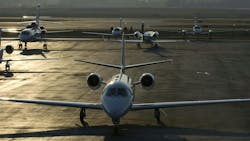Rates, Charges and the Future of the General Aviation Ecosystem

At general aviation airports, few regulatory issues create more confusion and contention than airport rates and charges. These fees – including landing fees, lease rates and other use-based charges—are intended to help ensure airports remain self-sustaining while maintaining compliance with Federal Aviation Administration (FAA) grant assurances.
In the current environment, many airport sponsors face heightened pressure to meet capital and operational needs in the midst of fluctuating federal funding, rising costs and limited revenue streams. As a result, how airports fund their operations—and what alternatives exist beyond raising user fees—have become increasingly urgent concerns to general aviation tenants, users and operators.
Navigating the Current Financial Landscape
While the FAA provides airport sponsors flexibility in selecting a fee-setting methodology, that flexibility is not without limits. Adding to the complexity is the absence of clearly defined guidance on how rates and charges should be calculated and applied – often making the determination of what is equitable and transparent a matter of interpretation.
As aviation businesses plan for long-term investment and airport sponsors work to ensure financial stability, consistent national standards are needed to bring greater predictability, transparency and trust to the process. This financial landscape prompts key questions:
What does the ecosystem of general aviation look like over the next 20 years if federal support declines and costs continue to climb? What can the general aviation industry do to protect airport assets and the integrity of the national airspace system?
Across the country, many airports have traditionally relied on federal funding—particularly Airport Improvement Program (AIP) grants—to maintain staffing levels and complete critical capital projects. However, under the new federal administration, those funding streams may no longer be guaranteed.
Additionally, some states have diverted aviation-generated revenues, intended to support AIP matching grants and other specific state programs, for non-aviation uses – placing further strain on airport budgets. This practice undermines the intended purpose of aviation taxes and fees and contributes to a cycle where operators face higher charges to offset funding gaps. California, for example, has introduced a law (SB 661) that legislatively redirects earmarked aviation fuel taxes away from the state’s highway and general fund back to the aeronautics fund.
As financial tensions intensify, it’s important to recognize that raising fees should not be the first or only option to increase airport revenue. Airport sponsors have an opportunity—and in many cases, an obligation—to explore other revenue-generating strategies before raising fees and charges.
How Fees are Set: Methodologies and Gaps
To understand these challenges, it helps to know how airports generally set aeronautical fees. Per the FAA’s Rates and Charges Policy, last updated in 2013, fees must be reasonable, non-discriminatory and compliant with federal rules. Three common approaches are used:
1. Cost-Based (Compensatory) Approach
Fees are based on the airport’s actual costs to operate and maintain specific facilities. Users pay only for the services they use, and the airport assumes the financial risk if revenues fall short.
2. Cost-Sharing (Residual) Approach
Users agree to cover the airport’s total costs, after accounting for non-aeronautical revenues, often in exchange for lower fees or operational input. This model shifts financial risk to the users and is most common at commercial airports, but can be adapted for general aviation through long-term leases or partnerships.
3. Hybrid Approach
Fees are determined using a combination of cost-based and market-driven models. Airports may apply cost-based rates to facilities like landing fees and hangar leases, while using negotiated or market-based rates for others, such as fuel farms or maintenance areas.
While these methods are all acceptable to the FAA, there are no standardized formulas or rules on how to apply them, leading to wide disparities across airports. One area where inconsistency is especially pronounced is landing fees. Common at commercial airports, landing fees are increasingly being introduced at general aviation airports – often with limited stakeholder engagement or clear explanation of the underlying methodology.
FAA policy permits landing fees as long as they are grounded in cost-based or market-supported calculations and applied in a non-discriminatory manner. However, inconsistent or unclear implementation at some airports has raised concerns about how fees are derived, whether they reflect actual airfield costs, and how they will be assessed and collected.
Additionally, airports are facing increased pressure from some community and political stakeholders to implement misdirected landing fees as a tool to limit or influence aircraft operations. However, employing rates and charges with the intent to directly or indirectly restrict access – especially when based on questionable methodologies—violates federal grant assurances and the Airport Noise and Capacity Act (ANCA).
National trade associations like the National Business Aviation Association and National Air Transportation Association are tracking these developments with increased engagement at the state level. Notably, the National Association of State Aviation Officials, which represents the interests of state aviation agencies before federal policymakers, is not positioned to directly challenge the authorities it represents.
This disconnect between federal oversight and state autonomy creates a structural gap in advocacy—leaving general aviation airports more vulnerable to fragmented or inconsistent policies. It also underscores a deeper challenge: defining the appropriate balance of authority in managing a system that is, by design, national. Ultimately, this could possibly lead to interstate commerce concerns for commercial operators.
Just as the federal highway system relies on consistency across states, so too does the national airspace system. Yet, general aviation airports are often subject to varying local rules that can deter investment and undermine long-term viability.
Pursuing Diverse Revenue Streams
In the face of this challenge, airport sponsors can still take proactive steps to promote fairness and transparency. For example, maximizing income from currently vacant or underutilized property can play a key role. This includes implementing creative and strategic commercial development plans that attract both aeronautical and non-aeronautical tenants, encourage substantial private investment and generate long-term financial return.
Another important tool is the use of competitive Requests for Proposals (RFPs) for aeronautical leases and services. By introducing market competition, RFPs allow prospective tenants or operators to submit proposals based on transparent, pre-established criteria, helping to ensure that rates reflect fair market value.
While not a replacement for cost recovery models or financial oversight, RFPs enhance both by fostering open competition and objective decision-making. They also support FAA grant assurance compliance by demonstrating that leases or contracts are awarded fairly. Perhaps most importantly, RFPs build investor confidence, encouraging tenants to commit resources and plan for long-term success when the selection process is clear and consistent.
Toward a More Predictable and Equitable Future
While broader policy questions continue to evolve, stakeholders across the general aviation community can take meaningful steps to improve rate-setting practices. Airport sponsors, for example, can build trust with tenants by documenting how costs are allocated, keeping appraisals current and clearly explaining the basis for lease rates, landing fees or fuel flowage charges.
Tenants and operators also play an important role. Engaging early in the rate-setting process by asking questions, reviewing documentation and participating in constructive dialogue helps ensure that outcomes reflect operational realities and shared interests.
Industry associations can further support this effort by promoting best practices, offering educational tools and advocating for a more standardized approach to rates and charges that balances flexibility with fairness, as well as local autonomy with national guidance.
At its core, airport pricing is about more than compliance—it shapes the future of general aviation. Without consistent federal guidance and a unified approach to funding and fee structures, even well-intentioned policies risk being misapplied or misunderstood.
By working together to modernize rate-setting practices, align state and federal responsibilities, and pursue more strategic funding solutions, the FAA, airport sponsors and industry partners can help secure a strong and sustainable future for general aviation.
About the Author

Curt Castagna
President and CEO
Curt Castagna, President/CEO of Ascension Group Partners, serves as president and CEO of the National Air Transportation Association, member and past chair of the Los Angeles County Airport Commission, and president of the Van Nuys and Long Beach airport associations. A certified private, seaplane and instrument-rated pilot, he continues to instruct courses in aviation administration at Cypress Community College and Cal State Los Angeles.